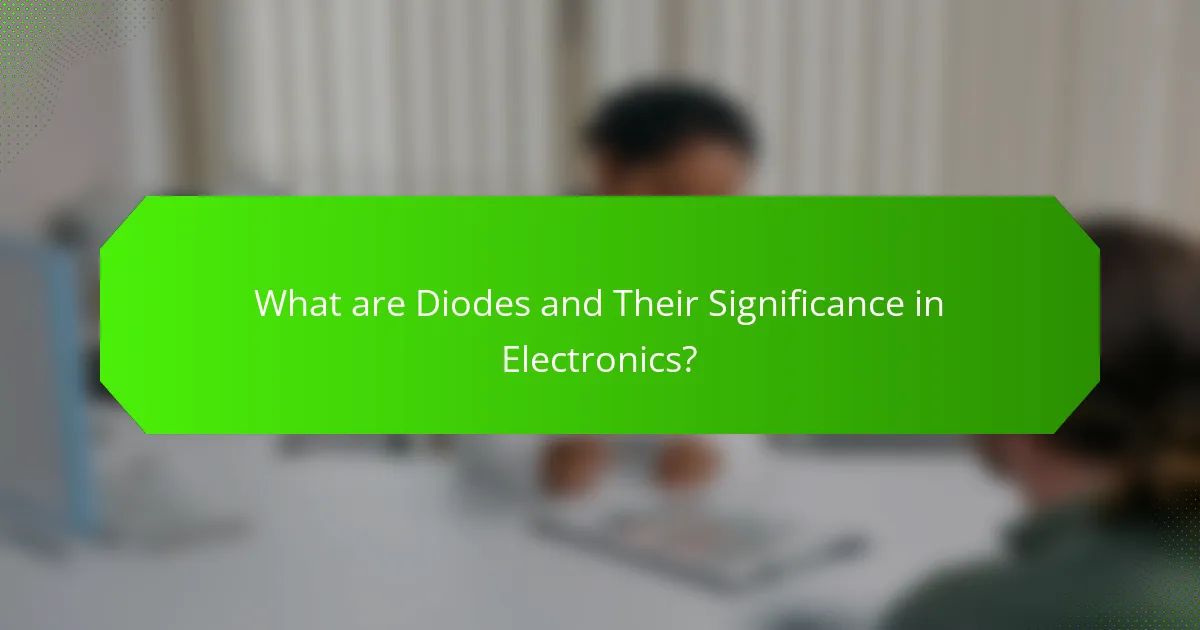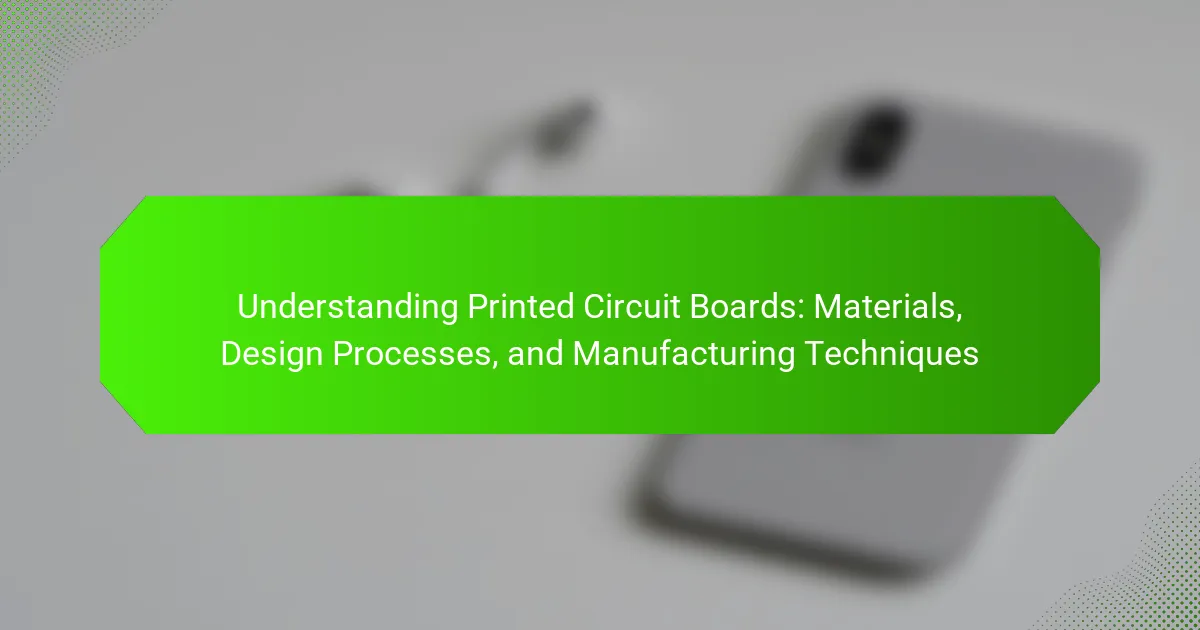Diodes are semiconductor devices that facilitate unidirectional current flow, making them essential components in electronic circuits. They perform critical functions such as rectification, converting alternating current (AC) to direct current (DC), and protecting circuits from voltage spikes. This article provides an overview of various types of diodes, including rectifier, Zener, and Schottky diodes, along with their working principles and common applications in electronics. Key considerations for selecting and implementing diodes in circuit design, such as specifications and heat dissipation, will also be discussed to enhance circuit efficiency and reliability.

What are Diodes and Their Significance in Electronics?
Diodes are semiconductor devices that allow current to flow in one direction while blocking it in the opposite direction. They are crucial components in electronic circuits. Diodes are used for rectification, converting alternating current (AC) to direct current (DC). This function is essential in power supplies for electronic devices. Additionally, diodes protect circuits from voltage spikes by clamping excess voltage. They are also used in signal modulation and demodulation in communication systems. The significance of diodes lies in their ability to control current flow, ensuring the proper functioning of electronic devices. Their reliability and efficiency make them fundamental in modern electronics.
How do Diodes function in electronic circuits?
Diodes function as semiconductor devices that allow current to flow in one direction only. They achieve this by utilizing a p-n junction, which creates a barrier that permits current flow when forward-biased. In forward bias, the p-type material is connected to the positive terminal and the n-type to the negative terminal. This reduces the barrier, allowing electrons to flow from the n-type to the p-type material. Conversely, in reverse bias, the p-type is connected to the negative terminal and the n-type to the positive terminal. This increases the barrier, preventing current flow. Diodes are commonly used for rectification, converting alternating current (AC) to direct current (DC). They also protect circuits by blocking reverse voltage that could cause damage.
What are the key components of a Diode?
A diode consists of two key components: the semiconductor material and the junction. The semiconductor material is typically silicon or germanium. This material allows current to flow in one direction. The junction is formed by joining p-type and n-type semiconductors. This junction creates a barrier that controls electron flow. When forward-biased, the barrier is reduced, allowing current to pass. In reverse bias, the barrier increases, preventing current flow. These components enable the diode’s primary function as a rectifier in electronic circuits.
How does the semiconductor material affect Diode performance?
The semiconductor material significantly affects diode performance. Different semiconductor materials have distinct electrical properties. For instance, silicon is commonly used due to its good thermal stability and moderate bandgap. Gallium arsenide, on the other hand, offers higher electron mobility, which leads to faster switching speeds.
The bandgap energy of the semiconductor determines the diode’s forward voltage drop. A narrower bandgap results in lower voltage drop but potentially higher leakage currents. Conversely, a wider bandgap can enhance efficiency in high-temperature applications.
Additionally, the doping levels within the semiconductor influence the diode’s conductivity and response time. Heavily doped semiconductors provide lower resistance, improving current flow.
In summary, the choice of semiconductor material directly impacts key performance metrics like voltage drop, switching speed, and thermal stability in diodes.
What are the different types of Diodes?
The different types of diodes include standard diodes, Zener diodes, Schottky diodes, light-emitting diodes (LEDs), and photodiodes. Standard diodes allow current to flow in one direction. Zener diodes permit reverse current flow at a specified voltage. Schottky diodes feature low forward voltage drop and fast switching speeds. Light-emitting diodes (LEDs) emit light when current passes through them. Photodiodes convert light into electrical current. Each type serves specific functions in electronic circuits, contributing to diverse applications.
What is a standard Diode and how is it used?
A standard diode is a semiconductor device that allows current to flow in one direction only. It consists of p-type and n-type materials forming a junction. This junction creates a barrier that must be overcome for current to pass. When forward-biased, the diode conducts electricity. When reverse-biased, it blocks current flow. Standard diodes are commonly used for rectification in power supplies. They convert alternating current (AC) to direct current (DC). This function is essential in various electronic circuits. Diodes also protect circuits by preventing reverse polarity damage.
What are the characteristics of Zener Diodes?
Zener diodes are semiconductor devices designed to allow current to flow in the reverse direction when a specific voltage, known as the Zener voltage, is reached. They are characterized by their ability to maintain a constant output voltage despite variations in input voltage or load current. This feature makes them ideal for voltage regulation applications. Zener diodes exhibit a sharp breakdown voltage, which is the point at which they begin to conduct in reverse. They typically have a low dynamic resistance, allowing for stable operation in regulation circuits. Additionally, Zener diodes can be used in both series and parallel configurations. Their temperature coefficient is important for stability, as it affects the Zener voltage across varying temperatures.
How do Schottky Diodes differ from traditional Diodes?
Schottky diodes differ from traditional diodes primarily in their construction and operation. Schottky diodes use a metal-semiconductor junction, while traditional diodes utilize a p-n junction. This difference leads to a lower forward voltage drop in Schottky diodes, typically around 0.2 to 0.3 volts, compared to 0.6 to 0.7 volts in traditional diodes. Schottky diodes also have faster switching speeds due to their lack of minority carrier charge storage. This makes them ideal for high-frequency applications. Additionally, Schottky diodes exhibit lower reverse recovery time, enhancing their performance in switching power supplies. These characteristics make Schottky diodes suitable for applications like rectification and voltage clamping.
What are the applications of Light Emitting Diodes (LEDs)?
Light Emitting Diodes (LEDs) have various applications across multiple fields. They are commonly used in lighting solutions, including residential and commercial lighting. LEDs are also utilized in display technologies, such as televisions and computer screens. In automotive applications, they serve as indicators and headlights. Additionally, LEDs are employed in traffic signals and signage for enhanced visibility. Their energy efficiency makes them ideal for portable devices and backlighting in electronics. Furthermore, LEDs are applied in medical devices for therapeutic purposes. According to the U.S. Department of Energy, LEDs use up to 75% less energy than incandescent lighting, reinforcing their widespread adoption.
What are the common uses of Diodes in electronics?
Diodes are commonly used in electronics for various functions. They primarily serve as rectifiers, converting alternating current (AC) to direct current (DC). This is essential for powering electronic devices that require DC voltage. Diodes also function as signal modulators, allowing for the manipulation of signals in communication systems. Additionally, they are used in voltage regulation, maintaining a consistent output voltage despite variations in input. Diodes protect circuits by blocking reverse current, preventing damage to sensitive components. They are integral in light-emitting diodes (LEDs), which emit light when an electric current passes through. These applications highlight the versatility and importance of diodes in electronic circuits.
How are Diodes utilized in rectification processes?
Diodes are utilized in rectification processes by allowing current to flow in one direction while blocking it in the opposite direction. This property enables diodes to convert alternating current (AC) into direct current (DC). In a typical rectification circuit, diodes are arranged in configurations such as half-wave or full-wave rectifiers.
In a half-wave rectifier, a single diode conducts during one half of the AC cycle, allowing only positive or negative half-cycles to pass through. This results in a pulsating DC output. In contrast, a full-wave rectifier uses two or more diodes to conduct during both halves of the AC cycle, producing a smoother DC output.
The effectiveness of diodes in rectification is supported by their forward and reverse bias characteristics. When forward-biased, a diode has a low resistance, allowing current to flow. When reverse-biased, it presents high resistance, effectively blocking current. This behavior is fundamental to the operation of power supplies and electronic devices that require stable DC voltage.
What role do Diodes play in signal modulation?
Diodes play a crucial role in signal modulation by allowing signals to pass in one direction while blocking them in the opposite direction. This unidirectional behavior enables diodes to shape and control signal waveforms. In amplitude modulation (AM), diodes can rectify the signal, converting it from an alternating current (AC) to direct current (DC). This process is essential for extracting audio from radio signals. Additionally, diodes are used in frequency modulation (FM) for demodulating signals, where they help in detecting variations in frequency. Their ability to switch quickly makes them effective in high-frequency applications. Diodes also provide non-linear characteristics that are vital in creating modulation effects. This functionality is supported by their semiconductor properties, which allow for precise control of current flow.

How do Diodes improve circuit efficiency?
Diodes improve circuit efficiency by allowing current to flow in one direction while blocking it in the opposite direction. This characteristic reduces energy loss in circuits. When used in power supply circuits, diodes prevent reverse current, enhancing overall efficiency. They also minimize voltage drop, which contributes to lower power dissipation. For example, Schottky diodes have a low forward voltage drop, making them ideal for high-efficiency applications. Additionally, diodes can be used in rectification processes to convert AC to DC efficiently. This conversion is crucial in power systems, as it ensures that energy is used effectively.
Why are Diodes essential for protecting electronic components?
Diodes are essential for protecting electronic components because they allow current to flow in one direction while blocking it in the opposite direction. This unidirectional property prevents reverse polarity, which can damage sensitive components. For example, in power supply circuits, diodes safeguard against voltage spikes and surges. They also prevent back EMF from inductive loads, which can cause voltage spikes. In rectifier circuits, diodes convert alternating current (AC) to direct current (DC), ensuring that connected components receive the correct type of current. The effectiveness of diodes in these applications is well-documented in electronics literature, confirming their role in enhancing circuit reliability and longevity.
What types of surge protection do Diodes provide?
Diodes provide several types of surge protection, including transient voltage suppression (TVS) and Zener diode protection. TVS diodes are designed to clamp voltage spikes, protecting sensitive components from overvoltage conditions. They react quickly to transient events, absorbing excess energy. Zener diodes can also regulate voltage and protect circuits by limiting voltage levels. Both types are integral in safeguarding electronic devices from damage due to voltage surges. Their effectiveness is supported by their rapid response times and ability to handle high energy levels.
How do Diodes prevent reverse current flow?
Diodes prevent reverse current flow by allowing current to pass in one direction only. This is achieved through their p-n junction structure. The p-type side contains holes, while the n-type side contains electrons. When forward-biased, the diode conducts electricity easily. In reverse bias, the electric field widens the depletion region. This barrier prevents charge carriers from flowing, effectively blocking reverse current. As a result, diodes protect circuits from potential damage caused by reverse voltage.
What are the limitations of Diodes?
Diodes have several limitations. They only allow current to flow in one direction. This property limits their use in certain applications. Diodes have a forward voltage drop, typically around 0.7 volts for silicon diodes. This drop can affect efficiency in power circuits. Diodes also have a maximum reverse voltage rating. Exceeding this rating can lead to breakdown and failure. Additionally, diodes can be sensitive to temperature changes. High temperatures can increase leakage current, affecting performance. Lastly, diodes cannot amplify signals. This limits their application in analog circuits.
What factors affect the lifespan of a Diode?
The lifespan of a diode is affected by factors such as operating temperature, current levels, and voltage ratings. High operating temperatures can accelerate material degradation. Excessive current can lead to thermal runaway, damaging the diode. Operating beyond voltage ratings can cause breakdown and failure. Additionally, environmental conditions like humidity and exposure to contaminants can impact performance. Proper heat dissipation techniques can extend diode life. Regular monitoring of electrical parameters can also help maintain diode integrity.
How do temperature and voltage impact Diode performance?
Temperature and voltage significantly impact diode performance. Increased temperature typically reduces the diode’s forward voltage drop. This reduction can lead to higher current flow at a given voltage. Conversely, low temperatures can increase the forward voltage drop, limiting current flow.
Voltage also affects diode performance. A higher reverse voltage can lead to breakdown if it exceeds the diode’s maximum rating. This breakdown can damage the diode or alter its characteristics.
Specific studies indicate that for silicon diodes, the forward voltage drop decreases by about 2 mV per degree Celsius increase in temperature. This relationship illustrates the sensitivity of diode performance to temperature changes.

What are some practical tips for using Diodes in projects?
Use diodes to control current flow in one direction. This prevents damage to components in circuits. Choose the correct type of diode for your application. Common types include rectifier, Zener, and Schottky diodes. Ensure you understand the diode’s specifications, such as forward voltage and current rating. Place diodes in the correct orientation to avoid malfunction. Test diodes with a multimeter before installation to confirm functionality. Consider heat dissipation in high-power applications to prevent overheating. Integrate diodes into your circuit design to improve efficiency and reliability.
How can you choose the right Diode for your application?
To choose the right diode for your application, evaluate the specific requirements of your circuit. Consider the diode’s voltage rating, current rating, and switching speed. The voltage rating must exceed the maximum voltage in the circuit. The current rating should accommodate the expected load without exceeding limits. For high-speed applications, select a fast-switching diode. Additionally, assess the diode’s reverse recovery time for efficiency. Different applications may require specific types of diodes, such as Zener or Schottky. Understanding these attributes ensures optimal performance in your electronic design.
What considerations should be made regarding Diode ratings?
Considerations for diode ratings include maximum reverse voltage, forward current, and power dissipation. Maximum reverse voltage indicates the highest voltage the diode can withstand in reverse without breaking down. Forward current specifies the maximum current that can flow through the diode in the forward direction. Power dissipation represents the maximum power the diode can handle without overheating. These ratings ensure that the diode operates safely and effectively within its specified limits. Exceeding these ratings can lead to diode failure or reduced lifespan. For example, a diode rated for 1A forward current should not be subjected to currents exceeding this value during operation.
How can you troubleshoot common Diode-related issues?
To troubleshoot common diode-related issues, first check for visible damage on the diode. Look for signs like burn marks or broken leads. Next, use a multimeter to test the diode’s forward and reverse bias. A good diode should conduct in one direction and block in the other. If it conducts in both directions or does not conduct at all, it may be faulty. Measure the voltage drop across the diode when it is forward-biased. A typical silicon diode shows about 0.7 volts. If the reading is significantly different, the diode may be defective. Additionally, inspect the surrounding circuit for issues like incorrect polarity or excessive current. These factors can affect diode performance.
Diodes are semiconductor devices that allow current to flow in one direction while blocking it in the opposite direction, making them essential components in electronic circuits. This article provides an overview of diodes, covering their types, such as standard, Zener, Schottky, and light-emitting diodes (LEDs), as well as their working principles, including rectification and signal modulation. Key attributes of diodes, including their construction, performance factors, and applications in voltage regulation and circuit protection, are explored in detail. Additionally, the article discusses practical considerations for selecting and troubleshooting diodes in electronic projects.



